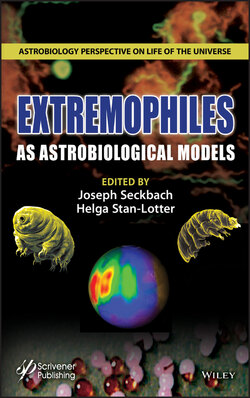Читать книгу EXTREMOPHILES as Astrobiological Models - Группа авторов - Страница 27
1.5 Cell Structure of Isolates
ОглавлениеFor scanning electron microscopy, cells fixed in glutaraldehyde and osmium were examined in an FEI Quanta 450 SEM. Images were recorded digitally. When individual cells were observed in the light microscope and cells tumbled, they appeared as irregular spheres. Similarly, in the scanning electron microscope cell isolates showed a generally irregular spherical SEM appearance (Figure 1.8). Most cells were less than 1µm in size and the nonsulfur cave isolate SW1 appeared as large (Figure 1.8a) and small groups (Figure 1.8a, insets). Paired and single cells more typically were seen in light microscope images (Figure 1.4a, b). The SW4 iron vent cells grown at pH 3 were highly concentrated and readily seen in SEM images as paired or single cells (Figure 1.8b). The cells appeared to be irregular spheres. At higher magnification, irregular ridges and depressions were prominent (Figure 1.8b, inset). This can be typical of later stages of growth when competition for food, and increased surface to volume ratios exist. The origin of ridges and depressions remains uncertain and requires further study to eliminate the possibility of artifact resulting from sample preparation. In the field of view shown here, the iron vent SW4 isolate had a few cell pairs that appeared to be held together by thin cell-to-cell bridges, presumably resulting from cell division. Though somewhat difficult to discern, one example marked by an arrowhead, is more readily visible in the inset. The thin cell bridge measured ~0.07 × 0.5 µm and tapered at both ends where it connected to cells. We did not determine that cells were motile as no flagella were seen, though some Archaea with flagella are known to be motile [1.9].
Figure 1.8 Scanning electron microscope images of steam vent isolates. (a) Cell cluster from nonsulfur steam cave SW1 with irregular spheres grown at pH 4.5, 80 °C. Left inset, SW1 phase contrast; right inset, SW1 DAPI stain. (b) Archaea grown from iron vent SW4 appear in the SEM mainly as pairs and single cells; arrowhead marks inset cell pair. Inset, ridges, depressions, and thin cell-to-cell connections appear. Cells grown at pH 3, 80 °C. Bar A, 3 µm. Bar B, 10 µm. Bar insets A (phase-DAPI stain), 5 µm. Bar inset B, 1 µm. (Image credit: the authors).
It seemed unusual that the two new Lassen isolates grew only at 80 °C, and not above. Yet, the habitat temperatures for nonsulfur cave (SW1) and iron vent (SW4) were 87 and 85.5 °C, respectively. Furthermore, in prior years the habitat temperatures were both above 90 °C. Temperature drops off quickly even at short distances away from the cave or vent opening. Thus, locations providing gases, nutrients or energy sources may not lie directly in the path of venting steam, possibly explaining the discrepancy between the higher environmental temperature and the lower isolation temperature. It may also be the case, as reported for hot springs [1.5], that different temperature strains exist within natural populations bridging a broader range of temperatures than that of the isolates obtained in our study.
